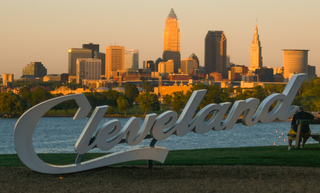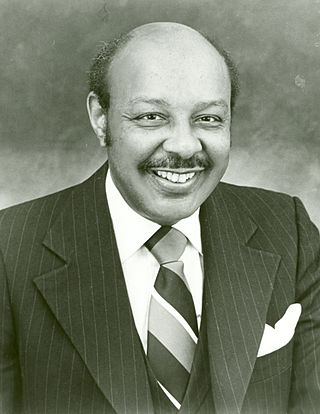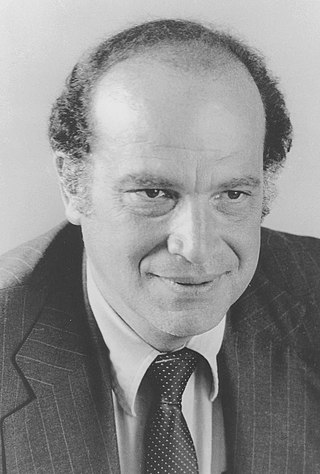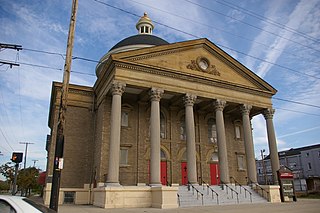Related Research Articles

Cleveland, officially the City of Cleveland, is a city in the U.S. state of Ohio and the county seat of Cuyahoga County. Located in Northeast Ohio along the southern shore of Lake Erie, it is situated across the U.S. maritime border with Canada and lies approximately 60 miles (97 km) west of Pennsylvania.

Robert George Seale is an American political activist and author. Seale is widely known for co-founding the Black Panther Party with fellow activist Huey P. Newton. Founded as the "Black Panther Party for Self-Defense", the Party's main practice was monitoring police activities and challenging police brutality in Black communities, first in Oakland, California, and later in cities throughout the United States.

Case Western Reserve University (CWRU) is a private research university in Cleveland, Ohio. Case Western Reserve was established in 1967 after Western Reserve University—which was founded in 1826 and named for its location in the Connecticut Western Reserve—and Case Institute of Technology—which was founded in 1880 through the endowment of Leonard Case Jr.—formally federated.

Carl Burton Stokes was an American politician and diplomat of the Democratic Party who served as the 51st mayor of Cleveland, Ohio. Elected on November 7, 1967, and taking office on January 1, 1968, he was one of the first black elected mayors of a major U.S. city.
Outhwaite Homes is a public development under jurisdiction of the Cuyahoga Metropolitan Housing Authority in Cleveland, Ohio. Built in 1935 by architects Edward J. Maier, Travis G. Walsh, and Leo J. Barrett and possibly named after Joseph H. Outhwaite, it was the first federally funded public housing in the Cleveland area and one of the first in the U.S. At the time of its opening, rent was listed at $4.78. The 100-plus-unit complex at East 55th Street and Woodland Avenue is, in autumn of 2011, in the final stages of redevelopment. The Outhwaite Homes, like other housing developments in the CMHA, provides residential housing for low-income families in the eastern section of downtown Cleveland.

Louis Stokes was an American attorney, civil rights pioneer and politician. He served 15 terms in the United States House of Representatives – representing the east side of Cleveland – and was the first African American congressman elected in the state of Ohio. He was one of the Cold War-era chairmen of the House Intelligence Committee, headed the Congressional Black Caucus, and was the first African American on the House Appropriations Committee.

The mayor of Cleveland is the head of the executive branch of government of the City of Cleveland, Ohio. As the chief executive in Cleveland's mayor–council system, the mayor oversees all city services and is "responsible for enforcing the city charter, city ordinances, and the laws of the State of Ohio." The mayor's office is located at Cleveland City Hall at 601 Lakeside Avenue in Downtown Cleveland. Since 1836, the city has had a total of 54 mayors, including the city's current mayor, Justin Bibb, encompassing 58 mayoral administrations, as four mayors have served in non-consecutive terms.

The written history of Cleveland began with the city's founding by General Moses Cleaveland of the Connecticut Land Company on July 22, 1796. Its central location on the southern shore of Lake Erie and the mouth of the Cuyahoga River allowed it to become a major center for Great Lakes trade in northern Ohio in the early 19th century. An important Northern city during the American Civil War, Cleveland grew into a major industrial metropolis and a gateway for European and Middle Eastern immigrants, as well as African American migrants, seeking jobs and opportunity.

The Glenville shootout was a gun battle that occurred on the night of July 23–24, 1968, in the Glenville section of Cleveland, Ohio, in the United States. Gunfire was exchanged for roughly four hours between the Cleveland Police Department and the Black Nationalists of New Libya, a Black Power group. The battle led to the death of three policemen, three suspects, and a bystander. At least 15 others were wounded.

Case Western Reserve University School of Law is one of eight schools at Case Western Reserve University in Cleveland, Ohio. It was one of the first schools accredited by the American Bar Association. It is a member of the Association of American Law Schools (AALS). It was initially named for Franklin Thomas Backus, a justice of the Ohio Supreme Court, whose widow donated $50,000 to found the school in 1892.

Cleveland State University College of Law is the law school of Cleveland State University, a public research university in Cleveland, Ohio. The school traces its origins to Cleveland Law School, founded in 1897, which merged in 1946 with the John Marshall School of Law to become Cleveland-Marshall Law School. It is accredited by the American Bar Association and is a member of the Association of American Law Schools.

Dr. Arthur J. Naparstek was a professor of social work and Dean of the Mandel School of Applied Social Sciences at Case Western Reserve University in Cleveland, Ohio. He was an expert on urban redevelopment and neighborhood revitalization whose community-building concepts served as the basis for local and national government programs in both the United States and Israel.

Hough is a neighborhood situated on the East Side of Cleveland, Ohio. Roughly two square miles, the neighborhood is bounded to Superior and Euclid Avenue between East 55th and East 105th streets. Placed between Downtown Cleveland and University Circle, Hough borders Fairfax and Cedar–Central to the South and Glenville and St. Clair–Superior to the North. The neighborhood became a target for revitalization during the mid-20th century, after the 1966 Hough Riots.
Ernest J. Bohn was an American politician. He was a leading figure in public housing from the 1930s until his death. He spent the majority of his life promoting the creation of public housing in Ohio, particularly in Cleveland, and his work created standards copied across the nation. Thanks to his efforts, Cleveland became a leader in public housing, creating the first public housing authority, Cleveland Metropolitan Housing Authority, and creating some of the largest public housing developments in the nation.

Central, also known as Cedar–Central, is a neighborhood on the East Side of Cleveland, Ohio. Situated on the outskirts of downtown, Central is bounded roughly by East 71st Street on its east and Interstate 90 on its west, with Euclid Avenue on its north and Interstate 77 and the Penn Central Railroad to the south. The neighborhood is eponymously named for its onetime main thoroughfare, Central Avenue. It is home to several schools, including East Technical High School.
The Case Western Reserve University Department of Biomedical Engineering launched in 1968 as one of the first Biomedical Engineering programs in the world. Formally incorporated in both the School of Engineering and School of Medicine, the department provides full research and education programs and is consistently top-ranked for graduate and undergraduate studies, according to U.S. News & World Report.

John Patterson Green was an American attorney, politician, public servant, and writer. He was among the first African Americans to hold public office in Cleveland, Ohio. A Republican, he was elected as a Justice of the Peace in 1873. He served in the Ohio House of Representatives in 1882. In 1891, he was elected to the Ohio Senate, the first African American state senator in Ohio. Green introduced the legislation that established Labor Day in Ohio as a state holiday.
The Greater Cleveland Associated Foundation was a community foundation established in 1961 in Cleveland, Ohio, in the United States to assist other private and community foundations in and around Cleveland in establishing priorities and working to find solutions to pressing social needs. After its second round of funding, GCAF leaders merged the foundation with The Cleveland Foundation, an organization which GCAF had greatly influenced.

The following is a bibliography of Cleveland, Ohio. It includes selected publications specifically about the city, Cuyahoga County, and the Greater Cleveland Metropolitan Area.
Geraldine Roberts (1924-1997) was an American domestic worker, grassroots organizer, and activist from Cleveland, Ohio. She founded the first documented domestic workers’ rights organization in the post-war U.S., Domestic Workers of America. Inspired by the Black Power and Civil Rights Movement, Roberts fought for the rights of working-class Black women throughout her life.
References
- 1 2 3 4 5 6 7 "Cleveland: Now!". The Encyclopedia of Cleveland History. Case Western Reserve University . Retrieved July 25, 2021.
- ↑ "Evans, Fred "Ahmed"". The Encyclopedia of Cleveland History. Case Western Reserve University . Retrieved July 25, 2021.